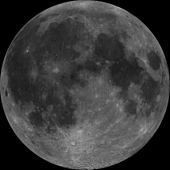The Moon is in synchronous rotation, which means it rotates about its axis in about the same time it takes to orbit the Earth. This results in it nearly always keeping the same face turned towards the Earth. The Moon used to rotate at a faster rate, but early in its history, its rotation slowed and became locked in this orientation as a result of frictional effects associated with tidal deformations caused by the Earth.[31] The side of the Moon that faces Earth is called the near side, and the opposite side the far side. The far side is often inaccurately called the "dark side,"


but in fact, it is illuminated exactly as often as the near side: once per lunar day, during the new

Moon phase we observe on Earth when the near side is dark.[32]
The topography of the Moon has been measured with laser altimetry and stereo image analysis.[33] The most visible topographic feature is the giant far side South Pole – Aitken basin, some 2,240 km in diameter, the largest crater on the Moon and the largest known crater in the Solar System.[34][35] At 13 km deep, its floor is the lowest elevation on the Moon.[34][36] The highest elevations are found just to its north-east, and it has been suggested that this area might have been thickened by the oblique formation impact of South Pole – Aitken.[37] Other large impact basins, such as Imbrium, Serenitatis, Crisium, Smythii, and Orientale, also possess regionally low elevations and elevated rims.[34] The lunar far side is on average about 1.9 km higher than the near side.[1]



0 comments:
Post a Comment